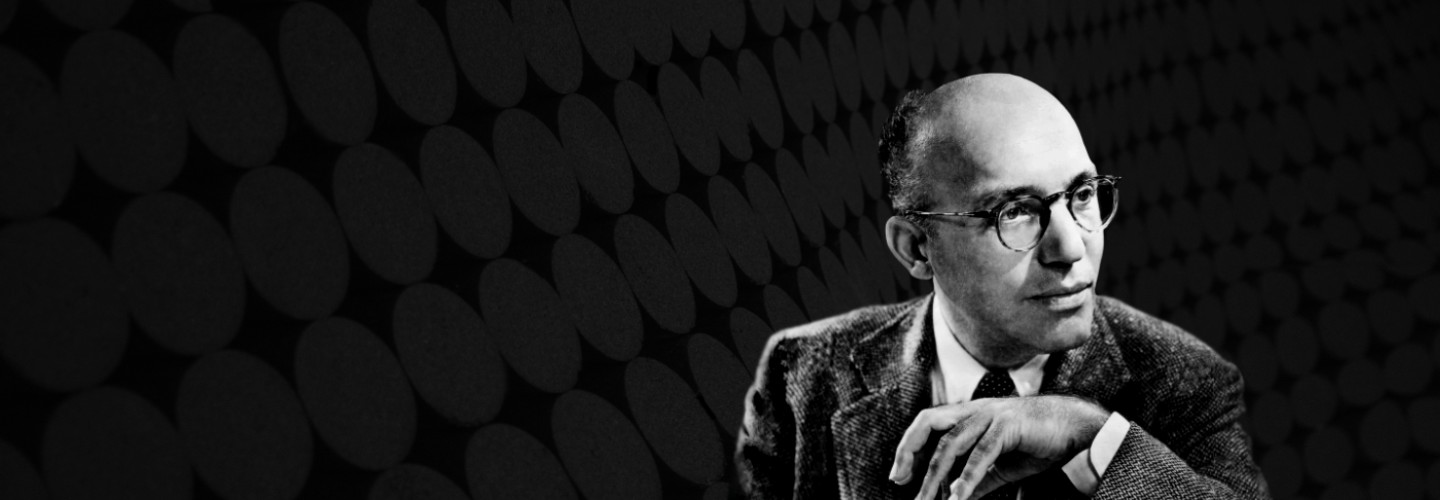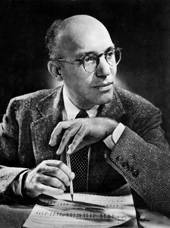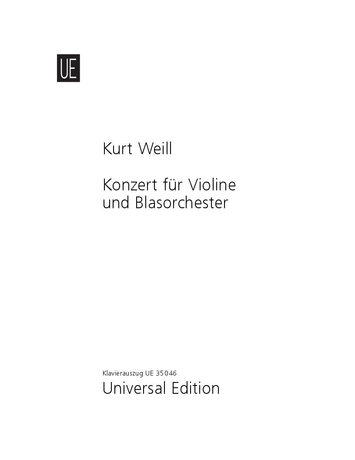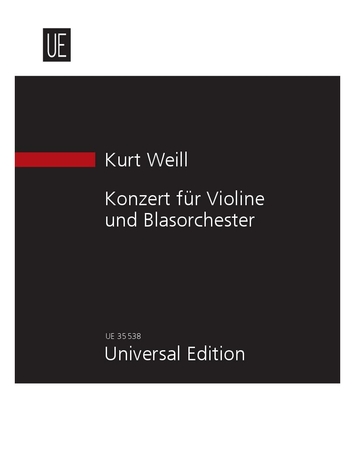

Kurt Weill
Concerto
Short instrumentation: 2 1 2 2 - 2 1 0 0 - timp, perc(3), cb(4)
Duration: 33'
Herausgeber: Andreas Eichhorn
Solos:
violin
Instrumentation details:
1st flute
2nd flute
oboe
1st clarinet in Bb
2nd clarinet in Bb
1st bassoon
2nd bassoon
1st horn in F
2nd horn in F
trumpet in C
timpani
percussion(3)
contrabass(4)
Weill - Konzert for violin and wind orchestra
Printed/Digital
Translation, reprints and more

Kurt Weill
Weill: Concerto for violin and piano - op. 12Orchestration: for violin and piano
Type: Klavierauszug

Kurt Weill
Weill: Concerto for violin and wind orchestra - op. 12Orchestration: for violin and wind orchestra
Type: Studienpartitur

Kurt Weill
Weill: Konzert (nach KWE) - op. 12Orchestration: für Violine und Blasorchester
Type: Dirigierpartitur (Sonderanfertigung)
Sample pages
Audio preview
Work introduction
Kurt Weill developed his creative energies mainly within the world of musical theater, where he proved to be an immensely productive and imaginative innovator, but he also left behind a small body of work for the concert hall. Nearly all of these works date from early in his career, when he studied briefly with Engelbert Humperdinck at the Berlin conservatory (1918/1919), and much more intensively in Ferruccio Busoni’s master class at the Prussian Academy of the Arts, where he was enrolled from 1921 to 1923. Here he composed his first mature works, such as the String Quartet Op. 8, which prompted Busoni to recommend his student to the Viennese publisher Universal Edition, where Weill was soon offered a contract.
The Concerto for Violin and Wind Orchestra Op. 12 dates from the spring of 1924. Weill began to conceive the work in February, but an extended trip to Italy interrupted his labors. In early April – back in Berlin – Weill composed the work relatively swiftly, although toward the end of May his progress stalled, as a letter to his sister conveys: ‘I’ve been very diligent and have completed two movements of a violin concerto. But in the last few days it’s been too hot to think anything through.’ A far greater distraction was Busoni’s grave illness. No longer a student, Weill had become a friend and confidant and visited Busoni daily, often to assist in various business matters. It is unknown whether they discussed the concerto during these visits, but Weill was shocked to see his revered mentor’s health decline so rapidly: ‘Busoni is deathly ill and none of us knows where our heads are. It would be less painful to suffer oneself than to see such a man suffer so terribly. When I’m not with him I have to bury myself in work in order to forget the sight of him.’ Conceivably, the darker mood of the concerto’s first movement, with its interwoven allusions to the ‘Dies irae’ (m. 47ff.), could be related to this context. At the end of June Weill notified his publisher that he had finished the work. Busoni died on 27 July 1924.
In search of a soloist for the concerto’s premiere, Weill first contacted the Hungarian violinist Josef Szigeti and offered to dedicate the work to him. Szigeti responded with an enthusiastic note, but he was unable to commit to a performance in the foreseeable future due to previous engagements, so he left it up to Weill to approach other candidates. Eventually the premiere was arranged with help from the French branch of the International Society for Contemporary Music; it took place on 11 June 1925 in Paris. Performed within the context of the ‘Exposition internationale des Arts décoratifs et industriels modernes’ – the international arts fair that gave rise to the term ‘art deco’ – the English conductor Walther Straram led the performance and Marcel Darrieux played the solo part (in 1923 he had given the world premiere of Prokofiev’s Violin Concerto No. 1). In October 1925 the work received its German premiere in Dessau, with Stefan Frenkel as soloist; he performed the concerto at least a dozen times in subsequent years (in Berlin, London, Warsaw, and Zurich, among other cities). In 1929 Hermann Scherchen conducted a radio broadcast of the concerto in Königsberg, and in 1930 Fritz Reiner led the American premiere in Cincinnati.
Scored for two flutes, clarinets, bassoons, horns, one oboe and trumpet, percussion, and four contrabasses, the concerto comprises three movements. While composing the work, Weill informed his publisher: ‘I am working on a concerto for violin and wind orchestra that I hope to finish within two or three weeks. The work is inspired by the idea – one never carried out before – of juxtaposing a single violin with a chorus of winds.’ At this point Weill could have had no knowledge of Stravinsky’s Concerto for Piano and Wind Orchestra (also with percussion and contrabasses), but he greatly appreciated the Russian composer’s L’histoire du soldat, which he had heard in Frankfurt in the summer of 1923. The second movement of Weill’s concerto, which consists of three character pieces, could have been inspired by Mahler’s Symphony No. 7. A friend of Weill’s, the conductor Peter Bing, called the Notturno ‘a true “night piece” in the [E.T.A.] Hoffmannian sense’, in which the xylophone plays a crucial role, whereas the Cadenza features the trumpet and the Serenata gives a prominent role to both oboe and flute (in addition to the violin). To contrast with the first movement’s subdued mood, Weill gave the final movement the characteristics of a tarantella.
In December 1925 Universal Edition had published Weill’s piano reduction as UE 8339 (with a separate violin part inserted), but four decades elapsed before the full score appeared in print. This posthumous publication disregarded Weill’s original score layout, conceived especially for his unusual forces: the solo instrument appeared in the top staff, the trumpet above the horns, and the bassoons as the lowest winds beneath the horns (similar to the score layout for a woodwind quintet). The full score published in 1965, however, conformed the score to a more conventional format, even though Weill’s forces are conventional neither in number nor in function. The new critical edition of the work, published in 2010 as part of the Kurt Weill Edition (Series II, Volume 2: Music with Solo Violin), which retains Weill’s layout, is based primarily on the holograph full score, but it also took into account the holograph piano reduction, a copyist’s manuscript of the solo violin part (which Stefan Frenkel used in 1925 to study the work), the published piano reduction, a copy of the published reduction inscribed by Weill to Frenkel (who again entered various performance annotations), and a manuscript copy of the full score prepared by Universal Edition in 1929. The present piano reduction follows the critical edition of the full score.
Old publisher’s catalogues issued before World War II list the performance duration of the concerto as 33 minutes. This information probably came directly from Weill in response to a request from Universal Edition in March 1930. Early recordings come in somewhat faster, probably in order to fit the work on one side of a long-playing disc (whose playing time was limited to a maximum of 30 minutes). Later recordings on CD followed the trend, even though this time limit was no longer relevant. A notable exception is a recording conducted by Hermann Scherchen in 1964: Instead of choosing faster tempos, Scherchen omitted a substantial section of the third movement in order to fit the work on one side of an LP. Even though the recording truncates Weill’s work, it preserves a different concept of tempos – a concept that may have some claim to authenticity, since Scherchen had attended a performance in 1926 in Zurich, where Weill himself was present, and Scherchen went on to conduct the concerto in 1929 with Frenkel as soloist.
The specific character of Weill’s concerto as music written for chamber orchestra (with an often soloistic treatment of instruments) leads to a transparency that requires utmost precision in the ensemble playing. In the quest for an overall sonic balance, the coarser-sounding wind instruments need to explore all dynamic nuances. The solo part is challenging not only from a technical standpoint but also from an acoustic one (it is crucial to make the violin ‘sound’). In spite of these challenges – or precisely because of them – critics in the 1920s called the solo part highly idiomatic and extremely rewarding. Since then the concerto has become a ‘modern classic’ in concert halls around the world.
Elmar Juchem
August 2010
